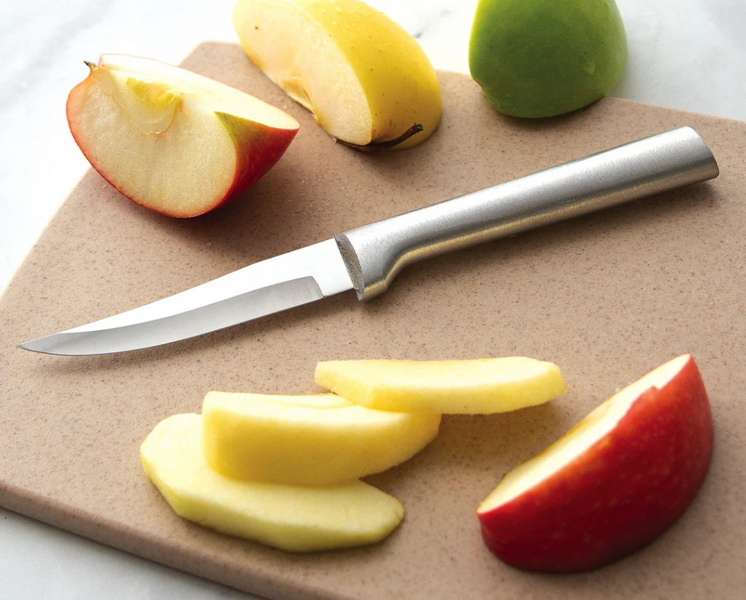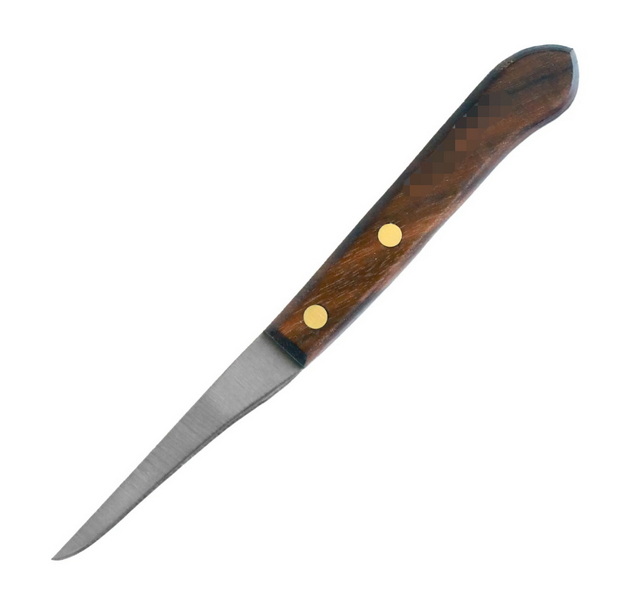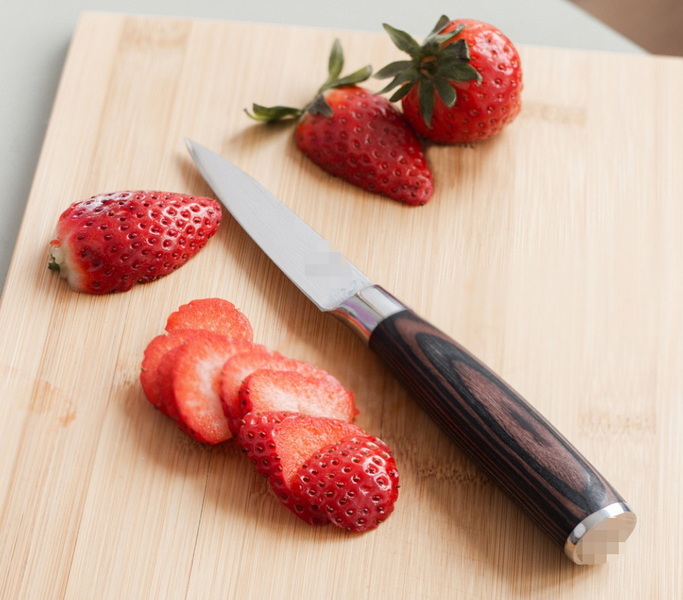- All
- Product Name
- Product Keyword
- Product Model
- Product Summary
- Product Description
- Multi Field Search
Views: 222 Author: Ann Publish Time: 2025-10-27 Origin: Site











Content Menu
● Key Features of Paring Knives
● Everyday Tasks Best Suited for Paring Knives
● Paring Knives vs Other Kitchen Knives
● Brand and OEM Considerations
● Real-World Use Cases and Dietary Applications
● FAQ
>> 1) What is the best blade material for Paring Knives?
>> 2) How do you properly maintain a Paring Knife?
>> 3) Can Paring Knives be used for meat trimming?
>> 4) How should Paring Knives be stored to prevent damage?
>> 5) What makes a good OEM Paring Knife for brand partnerships?
Paring Knives are among the most versatile tools in any kitchen. Their compact size, precise control, and razor-sharp blades enable a wide range of tasks that larger knives simply cannot perform with the same finesse. In this article, we explore how Paring Knives enhance everyday cooking, how to choose and care for them, and how to integrate OEM customization for brands seeking to differentiate in international markets.

A Paring Knife is a small knife, typically with a blade length between 2.5 and 4 inches (6.4 to 10 cm). The blade usually has a pointed tip and a balanced, ergonomic handle designed for precision work. Materials vary from high-carbon stainless steel to specialty alloys, and some premium models feature Damascus patterns or composite handles. For OEM applications, Paring Knives can be customized in blade shape, edge geometry, handle material, color, and branding to meet specific retailer requirements and consumer preferences.
- Size and weight: Light enough to maneuver with delicate tasks yet sturdy for detailed work.
- Blade geometry: A sharp tip and a fine edge enable peeling, trimming, and precision carving.
- Handle ergonomics: Contoured grips and non-slip textures reduce hand fatigue during extended use.
- Material options: Stainless steel, high-carbon stainless steel, and specialty alloys provide varying levels of hardness and corrosion resistance.
- Customization potential: Logo engraving, color handles, blade coatings, and certification marks support OEM branding.
Paring Knives excel at tasks requiring accuracy and finesse:
- Peeling and coring fruits and vegetables with controlled, shallow cuts.
- Deveining shrimp, trimming asparagus tips, and removing eyes from potatoes.
- Deseeding peppers, coring strawberries, and portioning small fruits.
- Creating decorative garnishes and intricate vegetable carvings.
- Small-scale trimming of meat or fish fillets where precision is essential.
- Proper grip: Use a pinch grip with the thumb and index finger placed on the blade spine for stability and control.
- Stable surface: Work on a non-slip cutting board and keep fingers away from the blade path.
- Cutting motion: Favor short, deliberate slices over long, sweeping motions to minimize slips.
- Maintenance: Wipe blades dry after use and store properly to prevent rust and dulling.
- OEM considerations: For brand partnerships, ensure coatings are food-grade and corrosion-resistant, and consider logo placement without compromising blade geometry.

- Cleaning: Hand wash with mild detergent and dry immediately to prevent corrosion.
- Sharpening: Hone regularly to maintain edge; schedule full sharpening based on usage and blade material.
- Storage: Use a magnetic strip, knife block, or blade guard to protect the edge.
- Material care: Avoid harsh acids that can degrade coatings; follow manufacturer guidelines for long-term care.
| Comparison | Paring Knife | Chef Knife | Utility Knife |
|---|---|---|---|
| Primary use | Precision tasks, peeling, trimming | General purpose slicing, heavy-duty tasks | Mid-size versatility, lighter tasks |
| Size | 2.5–4 inches blade | 6–12 inches blade | 4–7 inches blade |
| Control | High due to small size | Moderate; leverages weight | Moderate; versatile but less precise than paring |
| Best applications | Garnishes, intricate cuts, fruit prep | Large vegetables, meat, bread | Medium vegetables, fruit segments |
- Material sourcing: Choose appropriate steel grades (e.g., 410/420 stainless, VG series, or premium carbon stainless) based on target market and price point.
- Finish and coatings: Select food-grade coatings or laser-engraved logos that endure repeated washing.
- Handle options: Ergonomic scales, wood, or composite materials tailored to regional preferences and branding.
- Packaging: Retail-ready packaging, gift sets, and tamper-evident features aligned with importer requirements.
- Compliance: Ensure certifications for food safety and material compliance across international markets.
- Home kitchens: Everyday meal prep, fruit and vegetable trimming, and creative plating.
- Professional kitchens: Garnish work, portion control, and delicate fish or fruit preparations.
- Specialty brands: Premium handle materials and Damascus blade aesthetics to attract boutique retailers.
- OEM collaborations: Co-branding strategies with private-label packaging and marketing support to expand distribution.
Paring Knives are essential tools for achieving precision in everyday cooking. Their compact design, precise edge geometry, and adaptability make them invaluable for both home cooks and professionals. For brands seeking to differentiate in global markets, Paring Knives offer substantial customization opportunities—from blade materials and coatings to handle design and branding. By combining high-quality materials, ergonomic design, and thoughtful packaging, OEM manufacturers can deliver Paring Knives that meet diverse consumer needs while reinforcing brand identity.

- The best material depends on use and budget. Stainless steel variants such as high-carbon stainless offer a good balance of edge retention and corrosion resistance, while specialty alloys provide enhanced hardness for premium lines.
- Regular honing to maintain the edge, followed by periodic sharpening. Hand wash and dry immediately, store in a safe place, and avoid abrasive cleaners that could damage coatings.
- Yes, for small, precise trimming tasks and delicate meat shaping, though larger cuts are better suited to heavier knives.
- Use a magnetic strip, knife block, or blade guards to protect the edge and prevent accidental contact with other objects.
- Consistent blade geometry, durable coatings, ergonomic handles, reliable supply of high-quality materials, and branding options that align with retailer requirements.
The Ultimate Professional Knives for Halal Butchery in Middle Eastern Kitchens
Chef Knife Size Guide: Choosing Between 6″, 8″, 10″, And 12″
Custom Knife Handles: How To Design A Chef Knife That Fits Your Hand Perfectly
Chef Knife Surface Treatments Guide: From Polished Migaki To Damascus Patterns
Inside Our Professional Knife Sample Room: Quality You Can See
Universal Knife Block Buying Guide: Modern Acrylic & ABS Knife Holders for Professional Kitchens
Universal Knife Block: The Complete Guide To Modern, Hygienic Knife Storage
The Complete Guide To Red Handle Knife Sets: Style Meets Functionality in The Kitchen
Professional Knives for Halal Butchery And Middle Eastern Cuisine